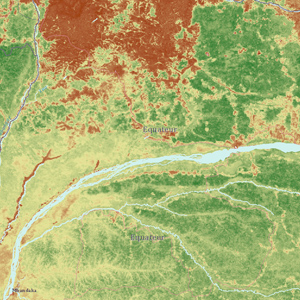
Global tropical carbon map. Courtesy of ESRI ArcGIS Online
Researchers have posted carbon stock data for the world’s tropical forests on ArcGIS Online, a web-based mapping platform developed by Esri.
The data, based on satellite measurements from NASA including LiDAR and MoDIS data as well as on-the-ground field measurements, reveals the biomass of tropical forests at a 500-meter resolution, the highest resolution ever published on a global scale. Rainforests in the Amazon, Borneo, New Guinea, and the Congo Basin are particularly carbon-dense, reflecting the importance of conserving these areas for climate change mitigation efforts.
 Carbon stock data for a section of forest in Equateur, DR Congo. |
“Knowing how much carbon is in these forests is key to devising effective programs and finances to conserve them,” said Eric Davidson, executive director of the Woods Hole Research Center, which led the research.
Scientists hope the maps can be used to estimate carbon dioxide emissions from deforestation. The data may help determine how much countries can earn from the proposed Reducing Emissions from Deforestation and Degradation (REDD+) program, which aims to compensate tropical nations for protecting their forests.
The basis for the data behind the new maps was detailed in a paper published in Nature Climate Change earlier this year. That study estimated carbon storage by global tropical forests at 229 billion tons.
Related articles
Rainforests store 229 billion tons of carbon globally finds new ‘wall-to-wall’ carbon map
January 30, 2012 – Tropical rainforests store some 229 billion tons of carbon in their vegetation — about 20 percent more than previously estimated — finds a new satellite-based assessment published in the journal Nature Climate Change. The findings could help improve the accuracy of reporting CO2 emissions reductions under the proposed REDD program, which aims to compensate tropical countries for cutting deforestation, forest degradation, and peatlands destruction.